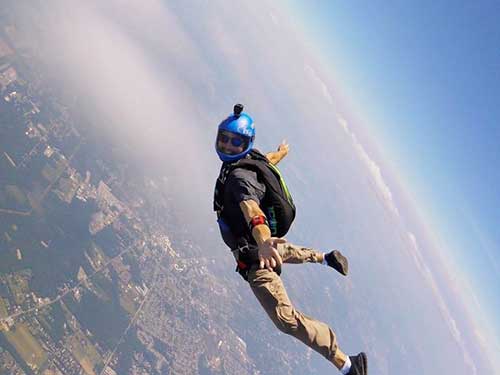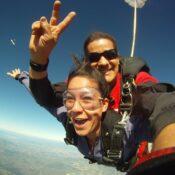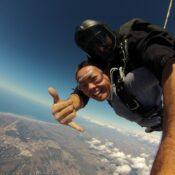
Beginner’s Guide: Transitioning from tandem to solo skydiving
If you’re reading this, we’ll take a guess and say you might fit into one of these categories:
- Your friends jump solo and you want to join the awesomeness of jumping with other people (that you’re not attached to)
- You’ve just always wanted to learn to solo skydive – you can’t explain it, you just do
- You already completed one or more tandem skydives and just can’t get enough
- You went on a tandem skydive and knew you wanted your instructor’s job
Whatever your reason for reading this post, it’s one step closer to jumping out of the plane with your own parachute. One of the most common questions we get from tandem students is “how do I start skydiving on my own?” Well, here’s a start — an overview of how to make the transition from tandem skydiving to jumping on your own, and the steps involved.
Your foundational tandem skydives
When it comes to solo skydiving, like most other things, you’ll have to start with the basics. Two tandem skydives are required within a 30 day period to begin. After your first tandem skydive, you’ll probably know at that point if you want to continue skydiving and continue learning beyond your tandem jumps. If you want to continue, let your instructor know that you want to transition to skydive on your own before your second tandem skydive. By knowing you want to advance to solo status, your instructor will brief you on a few additional items prior to your second jump (Tandem 2), which are specifically for those who want to advance. On your jump, you’ll work on basic turns when you’re in freefall and gain altitude awareness by wearing and reading an altimeter — a critical safety component to all skydives. In addition, you will get your feet wet with deployment procedures and learn how to control the canopy with your instructor’s assistance. Either way, check in with the dropzone staff and let them know that you want to start your Tandem 2 skydive to learn to skydive on your own!
AFP – Accelerated Freefall Progression
After you’ve completed (and passed) your Tandem 1 and Tandem 2 skydives, you can start the AFP course. AFP, or Accelerated Freefall Progression, is a program that consists of ground training and seven levels of skydiving (1 level = 1 jump) with an instructor that gets you on your way to jumping out of the plane on your own. Each level of the AFP program requires you to learn skills and perform specific tasks that you have to complete and demonstrate proficiently in order to pass to the next level. However before you get to the air, you need to learn the foundations of flight and safety with your feet on the ground – the First Jump Course.
Ground Training
Ground training is exactly what it sounds like – skydive training on the ground, also called a “First Jump Course”, or FJC. Taught by a USPA qualified instructor, this training takes approximately 4 to 6 hours to complete. In your FJC, you will learn the ins and outs of your gear, gear terminology and how it functions – both individual components and how each part works within the whole rig. You will also learn the basics of body flight in freefall, and how to safely maneuver your canopy to land in the designated landing area. A sizeable portion of the First Jump Course is safety, so you will also learn about common (and uncommon) malfunctions, how they can happen, and what to do if you do find yourself in one of those situations. Once you demonstrate knowledge in these areas (and a few more) successfully, you will pass ground training and be cleared for AFP level 1 – your first jump with your own parachute.
AFP Jumps: Levels 1 to 7
As you might know, there are 7 levels of AFP jumps. For each AFP skydive level, your instructor will brief you on the requirements of the jump. Each jump, or level, will have a set of objectives for you to accomplish. You and your instructor will exit the plane from 13,000 ft. From here, you will be required to complete a series of tasks in the sky and throughout your jump – from altitude awareness and certain maneuvers to landing safely. Because you are learning new skills in each level, not everyone passes every level the first time, so it is perfectly okay and common to repeat some levels. After you acquire that set of skills and accomplish your goals on each jump, you will pass to the next AFP level. AFP level 1 begins with your instructor holding on to you on exit and in freefall, and in later levels you’ll be doing flips, barrel rolls and more!
When you begin your AFP jump levels, the cost of your program will also include:
- USPA Instructor assisting you on your skydive
- Gear rental (parachute, jumpsuit, goggles, altimeter)
- Lift ticket to 13,000ft (at Skydive Santa Barbara; some other schools jump from lower altitudes)
- Your solo skydive
- Detailed post-jump debrief
- Repack of your parachute
- Skydivers logbook
- United States Parachute Association membership
Solo status and beyond
Once you’ve passed AFP levels 1 through 7, you’ll be cleared for solo status. From here you can work toward your A license, which ultimately allows you to jump at most USPA dropzones by yourself or in groups. To apply for your A license, you need to meet a series of requirements, have a minimum of 25 jumps, and also pass a written test to demonstrate skydiving proficiency. We’ll feature another post soon which will take a deeper dive into what it takes to get your A license. If you have questions though, don’t hesitate to ask.
Call us today to start on your path to solo skydiving! In the meantime, if you haven’t made your first tandem jump yet, we suggest this quick read on what you need to know before your first tandem skydive. Don’t forget to follow us on Facebook, Instagram and Twitter to see if photos from your skydive are featured sometime soon.
Blue Skies,
– The Skydive Santa Barbara Team



